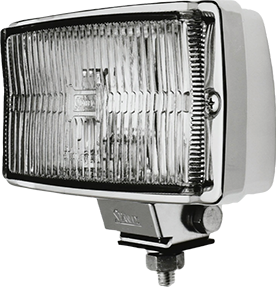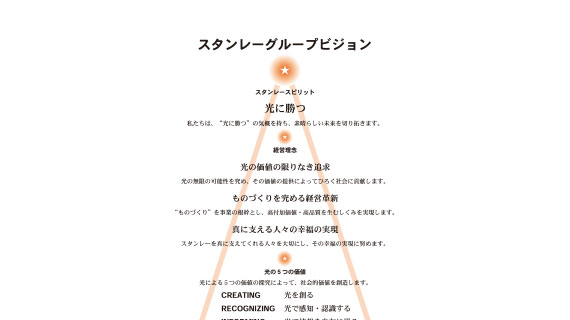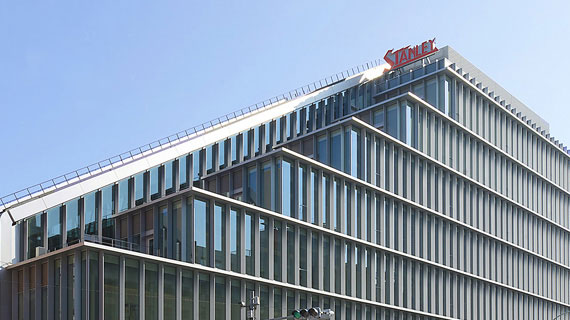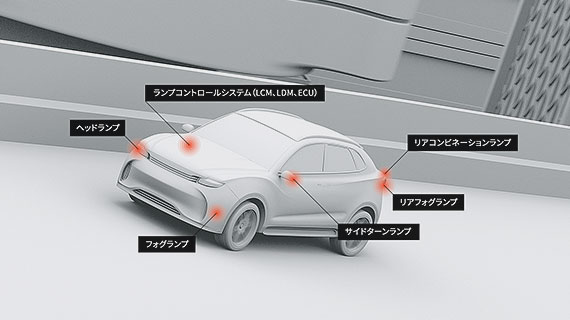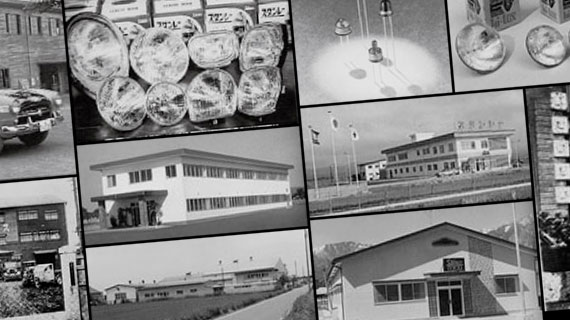- HOME/
- About Stanley/
- Stanley's 100th Anniversary Site
Stanley's 100th Anniversary Site

Advancement during High Economic Growth
In November 1962, the founder passed the baton to the next generation of leadership as Takaoki Kitano became the President. With the number of employees exceeding 1,000, the company made a shift to a group leadership structure that was suitable for its increased size. Internal systems were fundamentally reviewed and in-house specifications were standardized. Also, operational guidelines for business processes were formulated and the managing directors' meeting was set up as the top-level decision-making body. The sales network was expanded, and the production bases were enhanced and relocated to rural areas and overseas. Meanwhile, in order to strengthen the development system for new products, a Research & Development Laboratory was opened to advance existing technologies and improve products as well as to pursue new technologies for the future.
Download the Chapter 3 PDFCHRONOLOGY
Introduced the chairmanship. Takaoki Kitano appointed as President and Takaharu Kitano Chairman
The Appointment of Takaoki Kitano as President and Takaharu Kitano as Chairman
In November 1962, at the 45th ordinary general meeting of shareholders, a chairmanship system was established.
After the general meeting, the board of directors approved then-President Takaharu Kitano, the founder and leader of Stanley Electric, to be appointed as Chairman, and the company's presidency be handed over to then-Vice President Takaoki Kitano. The change in the top management provided new energy for the company's further progress.
Increased capital stock to 1,001,000,000 JPY
Launched infrared lamps
Established Stanley Iwaki Works
Launched the Super Fog
Established Taiwan Stanley Electric Co., Ltd.
Launched subminiature lamps
Launched numeric indicators
Expansion into Taiwan and the Establishment of Domestic Production Bases
As Japanese automotive manufacturers were rapidly expanding their overseas productions, car parts suppliers were also stepping up their efforts overseas. Stanley Electric's first overseas affiliate, Taiwan Stanley Electric Co., Ltd. (TWS), was established in July 1968. Taiwan Stanley Electric mainly produced light bulbs for stop lights and tail lights. Its business grew steadily--its monthly production reached 260,000 units three years after its foundation. It expanded production lines and started exporting to Japan, the U.S., Canada, South America, Australia, and other regions.
Meanwhile, in Japan, centralized production faced limitations in securing future manpower. Therefore, Stanley Electric considered decentralizing production with new factories in rural areas. First, Stanley Iwaki Works was founded in October 1967. Then, in May 1970, Stanley Niigata Works and Stanley Miyagi Works were established, and in August and October of the same year, Stanley Tsuruoka Works and Stanley Ina Works were opened, respectively. This was how production bases were decentralized.
Launched halogen lamps
Opened the Research & Development Laboratory
The Launch of Research & Development Laboratory
The company's research and development division was left uninvolved in some business activities. In order to transform it into a development department that was more dependable and effective for the entire company, serious discussions were held for a major cultural change under a scheme for a new technological development structure.
In August 1969, a mid-term technological development plan entitled "The Current Situation and the Future Advancement of Technological Development" was formulated in order for the company to develop original products to expand into new technological and industrial fields. On December 8, 1969, a Research & Development Laboratory was launched as the R & D base for the company's future.
The laboratory was designed to do research to add significant quality improvements to the company's existing products by proactively introducing new technologies and it also aimed to develop original products based on the company's own technologies and knowhow in order for it to enter new technological and industrial fields. The inauguration ceremony for the laboratory was attended by many people involved and led by Chairman Takaharu Kitano. All participants made a pledge that the laboratory was going to play a central role in the company's technological development.
Established Stanley Niigata Works
Established Stanley Miyagi Works
Established Stanley Tsuruoka Works
Established Stanley Ina Works
Listed on the First Section of the Osaka Stock Exchange
Introduced the chairmanship. Takaoki Kitano appointed as President and Takaharu Kitano Chairman
The Appointment of Takaoki Kitano as President and Takaharu Kitano as Chairman
In November 1962, at the 45th ordinary general meeting of shareholders, a chairmanship system was established.
After the general meeting, the board of directors approved then-President Takaharu Kitano, the founder and leader of Stanley Electric, to be appointed as Chairman, and the company's presidency be handed over to then-Vice President Takaoki Kitano. The change in the top management provided new energy for the company's further progress.
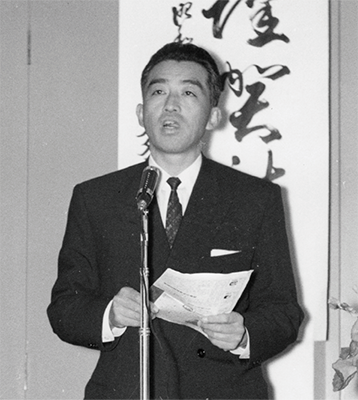
President Takaoki Kitano announcing the New Year management policy
Increased capital stock to 1,001,000,000 JPY
Launched infrared lamps
Established Stanley Iwaki Works
Launched the Super Fog
Established Taiwan Stanley Electric Co., Ltd.
Expansion into Taiwan and the Establishment of Domestic Production Bases
As Japanese automotive manufacturers were rapidly expanding their overseas productions, car parts suppliers were also stepping up their efforts overseas. Stanley Electric's first overseas affiliate, Taiwan Stanley Electric Co., Ltd. (TWS), was established in July 1968. Taiwan Stanley Electric mainly produced light bulbs for stop lights and tail lights. Its business grew steadily--its monthly production reached 260,000 units three years after its foundation. It expanded production lines and started exporting to Japan, the U.S., Canada, South America, Australia, and other regions.
Meanwhile, in Japan, centralized production faced limitations in securing future manpower. Therefore, Stanley Electric considered decentralizing production with new factories in rural areas. First, Stanley Iwaki Works was founded in October 1967. Then, in May 1970, Stanley Niigata Works and Stanley Miyagi Works were established, and in August and October of the same year, Stanley Tsuruoka Works and Stanley Ina Works were opened, respectively. This was how production bases were decentralized.

Taiwan Stanley Electric Co., Ltd. at the time of establishment, the first overseas subsidiary
Launched subminiature lamps
Launched numeric indicators
Launched halogen lamps
Opened the Research & Development Laboratory
The Launch of Research & Development Laboratory
The company's research and development division was left uninvolved in some business activities. In order to transform it into a development department that was more dependable and effective for the entire company, serious discussions were held for a major cultural change under a scheme for a new technological development structure.
In August 1969, a mid-term technological development plan entitled "The Current Situation and the Future Advancement of Technological Development" was formulated in order for the company to develop original products to expand into new technological and industrial fields. On December 8, 1969, a Research & Development Laboratory was launched as the R & D base for the company's future.
The laboratory was designed to do research to add significant quality improvements to the company's existing products by proactively introducing new technologies and it also aimed to develop original products based on the company's own technologies and knowhow in order for it to enter new technological and industrial fields. The inauguration ceremony for the laboratory was attended by many people involved and led by Chairman Takaharu Kitano. All participants made a pledge that the laboratory was going to play a central role in the company's technological development.
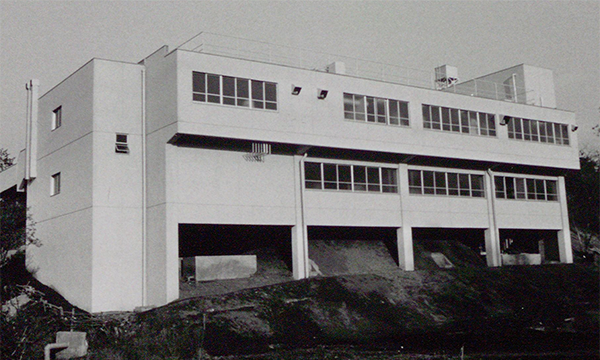
The first building of the Research & Development Laboratory
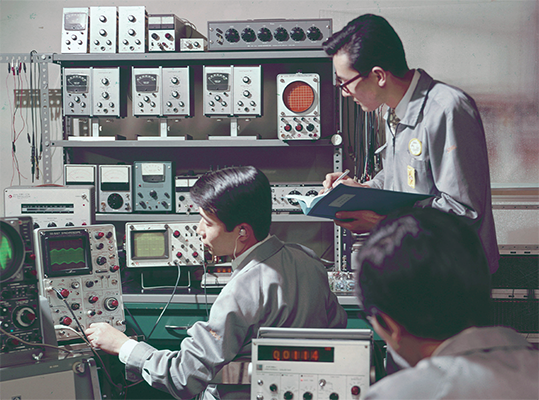
Engineers collecting experiment data
Established Stanley Niigata Works
Established Stanley Miyagi Works
Established Stanley Tsuruoka Works
Established Stanley Ina Works
Listed on the First Section of the Osaka Stock Exchange
